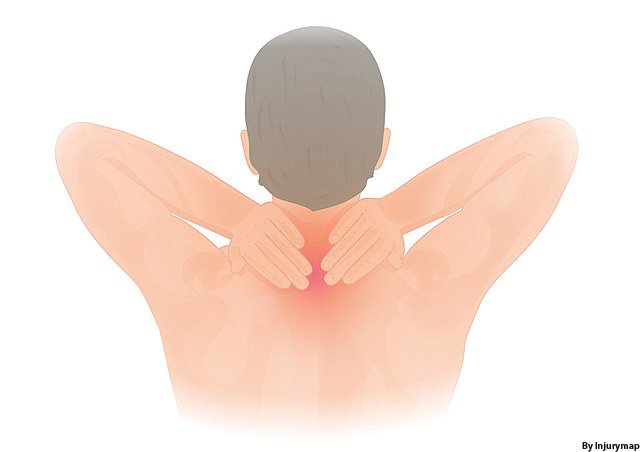by Eveline Wu, GCFP
Clients often enter my office after they have already worked with other practitioners for their neck pain. Maybe they have tried massage, physical therapy, chiropractic, or acupuncture, and found some relief. Yet when clients find themselves easily re-injured by everyday activities at work, they may still be seeking a way to create more lasting change.
A Feldenkrais® practitioner’s approach moves beyond thinking about one injured part of the body, like your neck, to how your whole body works together in movement. Because your neck connects to the rest of your body, the practitioner’s goal is to ease the movement patterns that strain your neck. Perhaps you have noticed excessive stress on your neck when you do movements like get up from a chair, jump, walk, reach for a shelf, or work at a computer. Neck pain often persists when these whole body connections remain unaddressed. When there is neck pain that feels connected to a heavy head sitting on top of a rather tiny part of your spine, your nervous system will sacrifice comfort in your neck. Thus, the Feldenkrais Method® emphasizes safety, gentleness, and finding connections to support you in being more skillful in your body.
There are many things beyond the neck that a Feldenkrais practitioner will sense and feel when working with you to help you feel more comfortable. A practitioner may think about how your neck is connected to your whole spine, all the way down to your pelvis and feet. They may think of the counterbalancing movements of your head and pelvis that go through your neck, and how movements of your ribs can reduce strain or provide support. A practitioner can help you discover how your whole body works together to look right and left, including your eyes. How you coordinate your posture in sitting, in walking, breathing, and how you use your arms can all have an effect on neck pain. Try clenching (gently) your fists or jaw now. Do you feel its effects on your neck? Your whole body is related to your neck, and by working with the improving those connections, you can reduce strain on your neck.
So bottom-line? It is all about connections!
Simple Neck Relief Activities– the Feldenkrais Way!
Try these movement activities to explore how you can work with your neck–beyond working with just your neck! As you do so, remember that the number one principle of the Feldenkrais Method is to move gently with pleasure so you can listen to yourself, and learn new ways of moving. Pleasure reinforces learning. So, please, remember, you are responsible for your well-being. Ease involves continuing to breathe, stopping before you feel resistance, and improving the quality of movement.
Each of these exercises can be repeated several times for a few minutes, or you can do them a bit more briefly in sequence.
Find a way you can be comfortable, maybe lying with a flat pad or folded towel that provides just gentle support, on a somewhat firm surface like the ground, rather than a mattress. Let yourself rest.
1) Gentle pelvic tilt, feeling movement through the spine to head.
Lying down, with your legs bent, so your feet are standing, gently tilt your pelvis to bring the back of your waist to the floor, and let go. Focus not on the end goal but on making it a smooth, easy movement. Do this without grabbing your abs, in a small, effortless way, several times, then let go to return to neutral. Then tilt your pelvis the other direction. Going very small, feel if you can soften your breathing to allow the movement to go towards your head. As you free your belly to tilt your pelvis and soften your breathing, you will feel a connection to your head. By coordinating your pelvis with your neck, you can begin to relearn support and balance.
2) Eye Movements with Your Pelvis
Still lying on your back, tilt your pelvis to bring your waist to the floor, while looking down towards your belly. Then tilt the other way to lift your waist, so your tailbone goes more towards the floor, looking up. Let your eyes go down as you title your pelvis towards your tailbone. Then explore looking up when you lower your waist and looking down as you lift your waist. Explore which way is easier.
3) Turn your head to one side, and move eyes opposite.
(This can also be done sitting.) Turn your head to one side, and back, only to feel how far it can go WITHOUT ANY STRETCHING. Then leave it turned in a place where it is easy, even if that is the tiniest amount or just an intention. Then take your eyes right and left. Then move your head to turn back and forth to that same side again. Only do one side at a time. Sometimes you will be able to turn further.
4) Gentle, slow eye circles.
This is a nice build up from the sequence above, but if your neck is super sensitive, you can start with this. See if you can take about 10-15 minutes to complete a circle, slowly moving your eye (pick your dominant eye) move in a slow circle. Like slowly drawing, going back and forth around one-quarter of your eye, until the movements are smooth, not jerky, and expand the movements further around the circle as they smooth out. (Most people with neck pain will have jerky eyes!) Make sure you breathing as you do this.
5) Return to pelvis tilts, then try very slow pelvic circles, and maybe try them with your eyes.
Tiny, tiny!
In these examples, I have focused on very basic ways of coordinating the eyes, pelvis, and head to support the neck. As I mentioned, there are many different connections. Each person is unique, and there are many different ways people end up in pain, and many ways out. The neck is also an energetic transition from mind to body. Working with you I bring a study of so many dimensions. In this way, we find out your needs and support your body wisdom to be incredibly intelligent when given the tools to change.
Let’s start simple so you can learn to move with more freedom, and ease.
 Eveline Wu has been working with clients with chronic pain and trauma for 18 years as a Guild Certified Feldenkrais Practitionercm. Her practice, Move and Feel Better, is in Oakland, CA. She is also a licensed Marriage and Family Therapist trained in many mind/body therapies. This article was abridged by Ira Feinstein from Eveline Wu’s blog, www.moveandfeelbetter.com
Eveline Wu has been working with clients with chronic pain and trauma for 18 years as a Guild Certified Feldenkrais Practitionercm. Her practice, Move and Feel Better, is in Oakland, CA. She is also a licensed Marriage and Family Therapist trained in many mind/body therapies. This article was abridged by Ira Feinstein from Eveline Wu’s blog, www.moveandfeelbetter.com

